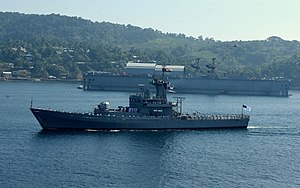|
Castle-class patrol vessel
The Castle class was a class of British offshore patrol vessels of the Royal Navy. Two ships were constructed and after nearly 30 years service were sold to the Bangladesh Navy in 2010. The Bangladesh Navy upgraded these with more armaments including C-704 anti-ship missiles and sensors. These ships are now reclassified as corvettes by the Bangladesh Navy. DesignThe Castle class was designed by David K. Brown and was intended as a series of six offshore patrol vessels for the Royal Navy, designed in response to criticism of the previous Island class for insufficient speed, sub-optimal sea-keeping and lack of a flight deck for rescue helicopters. In the event, only two ships were built, HMS Leeds Castle and HMS Dumbarton Castle. Both vessels were built by Hall Russell in Aberdeen, Scotland. These had significant improvements over the Island-class – they were 300 tonnes larger, more stable in heavy seas, 3 knots (5.6 km/h; 3.5 mph) faster and fitted with a large flight deck capable of supporting a Sea King helicopter. For brief periods, the ships could accommodate up to 120 troops. Their primary mission was to serve with the Fishery Protection Squadron, protecting both the fishing fleets and the oil and gas fields of the North Sea. They could also serve as minelayers, and had detergent spraying facilities on board for dispersing oil slicks. OperationsAfter the Falklands War, one ship was kept long-term in the Falkland Islands as a guard ship. Leeds Castle and Dumbarton Castle rotated the role on a three-yearly basis, although the ship's crew usually did a six-month rotation. ReplacementThe Castle class was replaced in the Falklands by a unique vessel based on the River class, HMS Clyde, and both vessels of the class were decommissioned. Originally due to transfer to the Pakistan Maritime Security Agency in 2007, the deal fell through and both ships were sold to the Bangladesh Navy.[1][2][3] Ships in class
References
Wikimedia Commons has media related to Castle-class patrol vessels. |
||||||||||||||||||||||||||||||||||||||||||||||||||||||||||||||||||
Portal di Ensiklopedia Dunia
